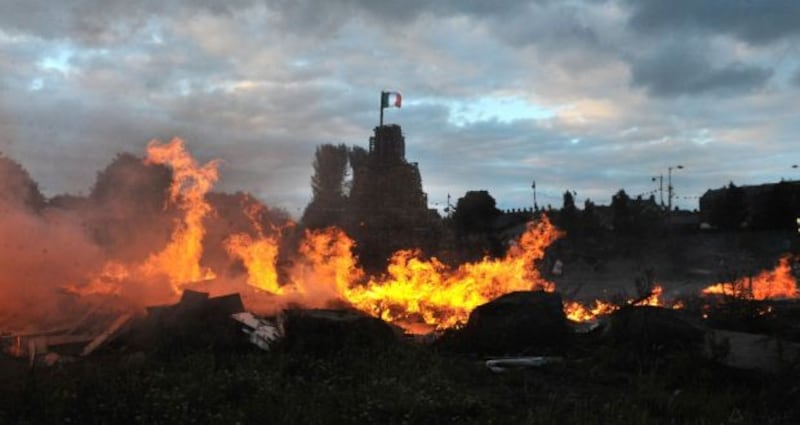I have a personal interest in the controversial bonfire of the moment.
Chobham Street in east Belfast made headlines last July when youths piled pallets between terraced houses and a community centre, threatening whole streets with spontaneous combustion.
The authorities did nothing, apart from hosing buildings down on the night, so damage was restricted to melting the Comber Greenway – a walking and cycling route that the bonfire had casually blocked.

Over the past year, while repairing the greenway, Belfast City Council installed a children's playground in the hope of positive deterrence. This proved futile and the playground equipment had to be moved last week to stop it melting as well. Only then did the youths shift their pallets a touch in the opposite direction.
I have watched this nudging by swing and roundabout week by week, as every Saturday for the past year my young daughter has attended a ballet class at the Chobham Street community centre, thudding adorably across its prefab floor.
To make a morning of it, my wife and I would take the greenway with our three children loaded into bicycle trailers (the most obnoxiously middle-class form of transport imaginable). Then we would have brunch behind the community centre at the literary-themed Lamppost Café.
Through its window across the street is the east Belfast office of the Alliance Party, now minus the round-the-clock police protection it needed for years after the 2012 loyalist flag protests.
This is not just the usual tale of Northern Ireland’s blithe bourgeoisie sitting on a sectarian bomb.
In the community centre is a "peace quilt". It is of poor quality but no worse than the example that once hung in the Ulster Museum, or, indeed, of much of our public art.
The quilt was made by people from an almost exclusively working-class Protestant neighbourhood. What its naff literalism unwittingly represents are the muffled voices of local residents, terrified of having their houses burned down, furious at having their amenities destroyed, yet even more scared of speaking out while the authorities surrender to thuggery.
Where is their police protection?
We know from political representatives and community workers that residents complain. But they must do so anonymously because the forces of law and order are apparently powerless against a handful of teenagers.
Same community
Of course, those teenagers come from the same community – and perhaps from the same homes as the despairing adults. But that only makes their abandonment by officialdom worse. Many a bicycle trailer is paid for in
Northern Ireland
by a job supposedly helping such families.
To understand what bonfires mean, it is important to understand what they are ceasing to mean. Despite appearances, they are less and less about loyalism or sectarianism and more and more about general underclass defiance.
Loyalists do muscle in on the funding schemes aimed at regulating bonfires. But a Chobham Street graffito, “Culture not Cash”, is the riposte to that – and a warning to loyalists themselves.
Irish flags, nationalist election posters and even Catholic religious items are placed on the pyres. But so are symbols of gay rights, racial equality and, this year, the European Union. Whatever polite society is for, the bonfire builders are obnoxiously against.
Last week Sinn Féin reported a "hate crime" after posters of two of its politicians appeared on a "family fun day" bonfire in Portadown. The arbitrary concept of "hate crime" epitomises the social conventions and control that many bonfires are deriding – and if "hatred" is prosecuted while all the other laws that bonfires break go ignored, the derision will be doubly successful.
Looking at the pictures posted online by Sinn Féin what is striking is how little fun the families seem to be having. Few in number and glum in appearance, they are skulking at a world they must know holds them in contempt.
Bonfire visits
I am from Portadown and can remember when bonfires attracted a more varied crowd. They were never a night at the opera (I have a friend who lost his virginity at one, aged 12), but a respectable sample of the Protestant population, in both senses of the word, would have visited a bonfire briefly or at least driven around the main sites for a look. Their gradual withdrawal reflects a critical difference between unionism and nationalism.
Sinn Féin stamped out the nationalist bonfire tradition, marking the August anniversary of internment through a plan of community action. Unionists do not work like this. We sense that something is wrong and drift away quietly one by one. What is left behind becomes socially unacceptable – and those we have left behind become somebody else’s problem.
There is debate over whether bonfires are culture, but this unionist cultural distinction will determine their future.








